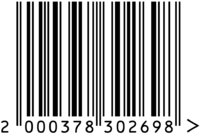World Registry
The World Government has no intention to replace existing and well-working registers such as ISBN (books), ISO 639 (languages) and so on.
We shall watch the developing registers as Global legal entities register (LEI), ISNI and ISTC and suggest additions to them.
And we are going to create the registers that has no satisfactory implementation in the world, for example: of states, religions, political internationals.
Already existing outer registers:
- legal entities, books, serial publications and public identities (see below)
- countries and rulers (see e.g. ISO Country codes, CIA World Leaders, Rulers.org)
- citizens and residents (see e.g. Global Identity Summit, Biometric Consortium, World Identity Network, Aadhaar)
- domains, sites and blogs (see TLD)
- languages (see ISO 639)
- mass media
TWG-created registers:
- sovereign states, including States that ceased to exist and States with limited recognition - http://states.world
- global political parties/internationals and organizations - http://org.world
- world religions - http://rel.world
- social networks - http://sonet.world
Books and publishers
The International Standard Book Number (ISBN) is 13-digit (formerly 9-digit in 1966-70; 10-digit in 1970-2006) number for books published since the standard was introduced. Includes EAN-prefix (3 digits: 978 or 979); country or language area code (1 to 5 digits); publisher code (1 to 6 digits); publication number (1 to 6 digits); check digit (one).
- Global Register of Publishers by International ISBN Agency - contains 2.060.257 publishers as of 22.11.2018.
- ISBN Wikipedia Article
- WorldCat by Online Computer Library Center (OCLC) is an attempt to unite bibliography databases for books and periodicals. It started in 1998 and now contains a. 400.000.000 records.
There is an idea to assign ISBN-like numbers (based on national bibliographies) to old books, that were published before ISBN implementation. It is briefly described here (in Russian)
Serials (Periodicals)
The International Standard Serial Number (ISSN) is an 8-digit code used to identify unambiguously newspapers, journals, magazines and periodicals of all kinds and on all media–print and digital. Started 1975.
- ISSN Database by ISSN International Centre - 2.665.621 titles are registered as of 22.11.2018
- ISSN Wikipedia Article
Public Identities
The International Standard Name Identifier (ISNI) is 16-digit identifier of publicly known natural persons, legal entities (mostly editorial) and even fictional characters. Mostly used by contributors to creative works and those active in their distribution, including researchers, inventors, writers, artists, visual creators, performers, producers, publishers, aggregators etc. Created in 2012 by librarians and therefore contains mostly names related to books.
- ISNI Database by ISNI International Agency - over 10 million identities, including 9.4 million individuals (since the time of Diogenes of Sinope) and 789,630 organisations as of 22.11.2018. Try to find yourself there. If you fail - write a book, send it to Library of Congress and wait... Or you can register your identity for some $30 in any local registration agency - usually a role in intellectual property creation is required (it can be your blog).
- ISNI Wikipedia Article
If you already have personal ISN, you can convert it to personal 13-digit barcode. The last issued ISNI number as of 22.12.2018 is 0000-0004-7407-1282 and while it always begins with 0000, next eleven digits (except check digit, the last in row) are enough for 100.000.000.000 (100 bn) persons. Your (unofficial) EAN-code can start with "2" (reserved 'country code' - not in use), eleven digits of personal number (5th to 15th letter in ISNI) and check digit.
For example, current Acting President of the World has ISNI 0000-0003-7830-2693. So, his personal number is 00037830269. We input 200037830269 at https://www.gs1.ch/en/home/offer/barcode/check-digit-calculator-and-ean-13-barcode-generator and receive check digit "8" and excellent barcode icon:

Legal Entities
Worldwide Legal Entities Register is being built under G20 Cannes Summit decision (2011) by Global Legal Entity Identifier Foundation (GLEIF). Now (November 2018) the LEI (Legal Entity Identifier) database includes about 1.3 million entities. Registration is voluntary, but in some countries LEI number is required for securities trade.
- Official LEI Database by GLEIF
- LEI.info - Extended LEI Database by Makolab (Poland) including data added by companies (website URL etc.) with advanced search options
There still exist some private initiatives, e.g. Dun & Bradstreet’s Data Universal Numbering System (D-U-N-S Number). It started in 1963 and now includes more than 300 million businesses worldwide.
Banks
- SWIFT BIC (Bank Identifier Codes) Database - more than 11.000 banks in the World